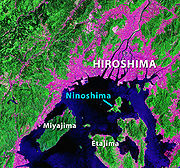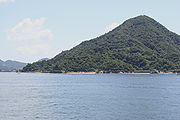
Ninoshima
Encyclopedia


Hiroshima
is the capital of Hiroshima Prefecture, and the largest city in the Chūgoku region of western Honshu, the largest island of Japan. It became best known as the first city in history to be destroyed by a nuclear weapon when the United States Army Air Forces dropped an atomic bomb on it at 8:15 A.M...
. Gakuen-mae pier on Ninoshima is located 4 km from Hiroshima (Ujina) Port. It takes only half an hour to get to Ninoshima from wharf 4 of Hiroshima Port (Ujina Port) by ferry. The island is 3.87 km² in size, and topped with the mountain Aki-no-Kofuji (278 m). In Japanese, the name of the island means "island similar to Fuji", as Ninoshima has a similar appearance and shape.
History
Military facilities were established in Ninoshima in the 1800s. During the First Sino-Japanese WarFirst Sino-Japanese War
The First Sino-Japanese War was fought between Qing Dynasty China and Meiji Japan, primarily over control of Korea...
, Ninoshima served as a quarantine station. During World War I
World War I
World War I , which was predominantly called the World War or the Great War from its occurrence until 1939, and the First World War or World War I thereafter, was a major war centred in Europe that began on 28 July 1914 and lasted until 11 November 1918...
, internment camps were located on Ninoshima to house German prisoners of war
Prisoner of war
A prisoner of war or enemy prisoner of war is a person, whether civilian or combatant, who is held in custody by an enemy power during or immediately after an armed conflict...
.
World War II
During the Second World War the island served as a quarantine centre for the Imperial Japanese ArmyImperial Japanese Army
-Foundation:During the Meiji Restoration, the military forces loyal to the Emperor were samurai drawn primarily from the loyalist feudal domains of Satsuma and Chōshū...
and Navy. On Ninoshima was built a dock, arsenal, facilities for the study of infectious diseases contracted by service personnel overseas, and a horse quarantine station. Training facilities for the 10th Training Unit of the Army Marine Training Division were also located on Ninoshima, as well as a fuel depot.
Nine kilometres from central Hiroshima, when the atom bomb
Nuclear weapon
A nuclear weapon is an explosive device that derives its destructive force from nuclear reactions, either fission or a combination of fission and fusion. Both reactions release vast quantities of energy from relatively small amounts of matter. The first fission bomb test released the same amount...
was dropped on Hiroshima
Hiroshima
is the capital of Hiroshima Prefecture, and the largest city in the Chūgoku region of western Honshu, the largest island of Japan. It became best known as the first city in history to be destroyed by a nuclear weapon when the United States Army Air Forces dropped an atomic bomb on it at 8:15 A.M...
on 6 August 1945, the island was unscathed by the initial blast. Therefore, for the following three weeks the island became the destination of victims of the atomic bombing
Atomic bombings of Hiroshima and Nagasaki
During the final stages of World War II in 1945, the United States conducted two atomic bombings against the cities of Hiroshima and Nagasaki in Japan, the first on August 6, 1945, and the second on August 9, 1945. These two events are the only use of nuclear weapons in war to date.For six months...
. In those weeks about 10,000 people were shipped to the island, to an emergency field hospital set-up there temporarily. The emergency field hospital operated from August 6 to August 25. Most of these were never to leave the island alive as thousands perished. The Hiroshima City War Victims Ninoshima Tower was erected on the island in 1947.
Post-war

Orphanage
An orphanage is a residential institution devoted to the care of orphans – children whose parents are deceased or otherwise unable or unwilling to care for them...
, set up in September 1946, for war orphans. After the war, the quarantine station continued to operate until 1958, when it was converted into the Fourth Municipal Junior High School, now the Ninoshima Elementary School and Ninoshima Junior High School.
In 1971, on the grounds of Ninoshima Junior High School was found a mass grave containing 571 victims’ skeletons. All the remains found were transferred to the Hiroshima Peace Memorial Park
Hiroshima Peace Memorial Park
is a memorial park in the center of Hiroshima, Japan. It is dedicated to the legacy of Hiroshima as the first city in the world to suffer a nuclear attack, and to the memories of the bomb's direct and indirect victims ....
, to the Atomic Bomb Memorial Mound. More remains were exhumed in 2004.
Present day
As of 2006, the population of the island is 1,168, including 662 households. In addition to the schools, Ninoshima has a ward office, post office, and environmental office.External links
- The Anger of Ninoshima, NHK Peace Archives

